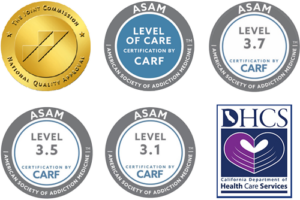How Long Does Oxycodone Stay in Your System?
Oxycodone addiction is a growing concern, with the drug’s potent effects and widespread availability contributing to its misuse. Understanding the duration that oxycodone remains in a person’s system is essential for various reasons, including medical treatment and drug testing purposes.
Having a general understanding of the duration of oxycodone in the body can aid in developing effective interventions and support for individuals struggling with addiction.
PSA: Don’t Lose Your Job or Go to Jail for Testing Positive for Oxycodone
If you’ve ever struggled with substance abuse and are worried you can lose your job if you test positive for an illegal drug, hope is on the horizon. If you agree to treatment for your addiction, your employer cannot fire you.
The same applies to those individuals who are required to submit to drug screening as part of probation or parole. If you test positive, but commit to treatment, you won’t go to jail.
Let Journey Hillside Tarzana help you on the road to recovery with our comprehensive addiction treatment programs and support. Take the fear and stigma away from addiction by seeking qualified treatment from our substance abuse experts, all in a comforting, supportive, and restorative environment. Call our intake specialists today at (877) 761-2723.
So, How Long Does Oxycodone Stay in System or Urine?
If you’ve ever wondered how long oxycodone or other drugs stay in your system and can be detected, the information below can be of benefit.
The detection window for oxycodone in urine can vary depending on several factors, including the individual’s metabolism, frequency and duration of use, dosage, and sensitivity of the test being used. In general, oxycodone can typically be detected in urine for approximately 3-4 days after the last use in occasional users. However, in chronic or heavy users, oxycodone may be detectable in urine for a longer period, up to 7 days or more. Oxycodone use has many variables; in a blood test or other type of drug analysis, the detection time may vary depending on factors like how efficiently your body will metabolize oxycodone.
How long does oxycodone stay in your system? There are numerous factors that influence the time and duration of effectiveness. These can include:
- General health of the individual
- Frequency of oxycodone use; if you use oxycodone regularly, more of the drug may remain in the system and can be detected
- type of oxycodone used, including controlled release oxycodone or immediate release formulations
- Use of other opioids
- Organ health, particularly liver health and the health of kidney function. As the liver metabolizes oxycodone, organ health is a critical factor.
It’s important to note that detection times for urine tests are estimates and can vary among individuals. Factors such as hydration level, kidney function, and the presence of other substances in the body can also influence the detection window for oxycodone in urine.
Additionally, different types of drug tests, such as immunoassay screening tests or confirmatory tests like gas chromatography-mass spectrometry (GC-MS), may have different detection thresholds and capabilities. Whether a saliva test or hair tests are performed, these different testing methods may produce different results and may or may not detect oxycodone in the same timeframes as a urine test.
As with any drug information, professional medical advice is the best bet when you have questions about opioids, opioid addiction, or how individualized treatment programs work.
What to know about drug tests, including a blood test or urinalysis
People should be aware of several key aspects regarding drug testing:
- Purpose: Drug tests are conducted to detect the presence of specific drugs or their metabolites in biological samples such as urine, blood, saliva, or hair. These tests are commonly used for various reasons, including pre-employment screening, monitoring substance abuse treatment, and legal or forensic purposes. A urine test may screen for one or more drugs, while a blood test or hair test may be used to detect oxycodone consumption history — in other words, looking for evidence of long-term use or misuse.
- Types of Tests: There are different types of drug tests to detect oxycodone, including urine drug tests, blood tests, saliva tests (oral fluid tests), and hair follicle tests. Each type of test has its advantages and limitations in terms of detection window, accuracy, and invasiveness. A urine test tends to be the least invasive, but results may not always be accurate. A saliva test has the same general benefits and limitations as urine samples. A blood test, on the other, hand, can detect oxycodone and other medications more accurately. Finally, hair tests can determine how long oxycodone addiction has taken place (to a degree) and can detect oxycodone long after use has stopped.
- Detection Windows: The detection window refers to the period during which a drug or its metabolites can be detected in a biological sample. The detection window varies depending on factors such as the specific drug, dosage, frequency of use, metabolism, time of the last dose, and type of test. It’s essential to understand the detection window for the drug being tested to ensure accurate results.
- Accuracy and Reliability: The accuracy and reliability of drug tests can vary depending on various factors, including the quality of the testing method, proper sample collection and handling procedures, and the presence of interfering substances. False-positive and false-negative results can occur, so confirmatory testing may be necessary to verify results.
- Legal and Ethical Considerations: Drug testing may raise legal and ethical concerns regarding privacy, consent, and discrimination. Employers, healthcare providers, and legal authorities must adhere to applicable laws and regulations governing drug testing, including obtaining informed consent and ensuring confidentiality of test results.
- Interpretation of Results: Interpretation of drug test results requires consideration of various factors, including medical history, prescribed medications, potential for cross-reactivity with other substances, and the context of testing. Positive results should be interpreted cautiously and verified through confirmatory testing if necessary. It is important to note that a sample cannot tell someone when the last dose was taken or if the positive result is an anomaly or a sign of substance abuse.
- Support and Resources: Individuals undergoing drug testing should be aware of available support services, including substance abuse treatment programs, counseling, and support groups. Open communication with healthcare providers and employers can help address concerns and facilitate appropriate interventions if needed.
It is important to note that if you have an addiction to your prescribed oxycodone, have an opioid use disorder, or are struggling with addiction to other substances, help is available. Overcoming oxycodone addiction is only a phone call away. Whether attending therapy sessions is right for you, or your struggle to overcome addiction needs a more rigorous approach like behavioral therapy, an inpatient treatment regimen, or other comprehensive treatment programs, professional drug treatment is within reach.
Better yet, you cannot be fired from your job if you fail a drug test and are actively seeking addiction treatment for opioid use disorder and the physical dependence that comes with drug abuse. Drug addiction need not be the end of a person’s life, but rather a dark chapter in an increasingly positive story.
Oxycodone: Medical and Illicit Uses
Oxycodone is a potent opioid medication primarily used for the management of moderate to severe pain. It belongs to a class of FDA approved medications and drugs known as opioid analgesics, which work by binding to opioid receptors in the brain and spinal cord to reduce the perception of pain. As the brain and central nervous system first processes the medication, feelings of relaxation and pain relief are common. Oxycodone affects the central nervous system and is commonly prescribed for various types of pain, including postoperative pain, cancer pain, and to treat chronic pain from conditions such as arthritis or back pain.
Pain Relief
Oxycodone is available in various strengths and types, including immediate-release formulations, extended-release forms, and oral solutions. Immediate-release oxycodone is often prescribed for acute or severe pain and relief on an as-needed basis, while extended-release formulations are typically used for chronic pain management to provide around-the-clock pain relief. Like other opioids in the class of painkillers, pain relief is the primary objective, helping the central nervous system to transmit fewer pain signals. The answer to the question of, “how long does oxycodone stay in your system?” depends on dosage, formulation, and numerous other factors.
In addition to its pain-relieving properties, oxycodone may also be combined with other medications, such as acetaminophen or aspirin, in formulations like Percocet or Percodan, to enhance its analgesic effects. In these prescription medication applications, oxycodone affects the nervous system and how pain signals are processed. However, it’s essential to use oxycodone cautiously and under the guidance of a healthcare professional due to its potential for misuse, dependence, and addiction.
A Word About Opioid Receptors
Opioid receptors are the body’s way of getting the drug into the system.
Opioid receptors are like specialized locks on the surface of certain cells throughout your body, including in the brain, spinal cord, and digestive tract. These receptors are designed to be activated by substances that fit into them just like a key fits into a lock.
When opioids, which can be natural or synthetic substances (like morphine or fentanyl), bind to these receptors, they trigger a series of events inside the cell. This leads to the main effects of opioids, such as reducing pain, creating feelings of pleasure, or causing sedation. Essentially, when the opioid key turns the receptor lock, it can either turn down the body’s pain signals or turn up feelings of relaxation and happiness.
However, because these receptors also control breathing and other vital functions, activating them excessively with powerful opioids can lead to serious problems like respiratory depression, where breathing slows down or stops, which is a major risk in opioid overdose.
Because the drug is so powerful, drug abuse becomes a serious concern. In some cases, individuals will become tolerant and take more oxycodone to achieve the same results. Eventually, this leads to opioid misuse or opioid use disorder. How long oxycodone stays in your system — the drug’s presence in detectable levels — is only one of many concerns associated with the misuse of this powerful drug.
What is Oxycodone Addiction?
In simple terms, oxycodone addiction refers to a compulsive and uncontrollable pattern of misuse or abuse of the opioid medication oxycodone.
Because oxycodone is a powerful painkiller commonly prescribed to manage moderate to severe pain, it also has a high potential for addiction and dependence. Addiction to oxycodone typically involves a person’s inability to control their use of the drug despite negative consequences, such as physical health problems, social difficulties, and interference with daily responsibilities.
Drug Addiction: Grave Effects
Individuals addicted to oxycodone may experience intense cravings for higher doses of the drug and may engage in behaviors such as doctor shopping, prescription forgery, or illicit drug seeking to obtain more of the substance. Over time, oxycodone addiction can lead to tolerance, meaning higher doses are needed to achieve the desired effects, as well as physical dependence, where abrupt cessation of the drug results in withdrawal symptoms. These higher doses influence how long oxycodone will stay in your system.
Oxycodone addiction is a serious medical condition that requires comprehensive treatment, including therapy, medication-assisted treatment, and support from healthcare professionals and loved ones.
Withdrawal Symptoms: How Long Oxycodone Influences the Human Body
Withdrawal symptoms from oxycodone addiction can vary in severity and duration depending on factors such as the individual’s level of dependence, the duration half life of oxycodone use, and the dosage of the drug. Common withdrawal symptoms associated with oxycodone addiction may include:
- Flu-like symptoms: These can include muscle aches, joint pain, sweating, chills, and fever.
- Gastrointestinal distress: Symptoms such as nausea, vomiting, diarrhea, and abdominal cramps are common during oxycodone withdrawal.
- Anxiety and agitation: Individuals may experience increased anxiety, restlessness, irritability, and agitation during withdrawal. Negative thought patterns can complicate long term recovery without supervised intervention.
- Insomnia: Difficulty falling asleep or staying asleep is a common withdrawal symptom.
- Mood changes: Depression, mood swings, and emotional instability can occur during withdrawal from oxycodone.
- Cravings: Intense cravings for oxycodone may be experienced, which can contribute to the risk of relapse.
- Physical symptoms: Other physical symptoms may include yawning, runny nose, dilated pupils, and goosebumps (piloerection).
Withdrawal symptoms from oxycodone typically begin within 6-12 hours after the last dose and peak within 1-3 days. Symptoms may gradually subside over the course of several days to weeks, although some individuals may experience protracted withdrawal symptoms, including persistent cravings and mood disturbances, which can last for weeks or months.
Explaining a Drug’s Half-life: Half the Drug?
A drug’s half-life refers to the amount of time it takes for the concentration of the drug in the body to decrease by half. This concept is particularly important in pharmacology and medicine as it helps determine the dosing frequency and duration of action of a drug.
For example, if a drug has a half-life of four hours, it means that after four hours, only half of the original dose remains in the body. That is oxycodone’s half life. After another four hours (totaling eight hours), only one-quarter of the original dose remains, and so on. Organ functions, including the kidney and liver function as well as the digestive system, form the foundation of oxycodone metabolism. An impaired liver, by contrast, means more of the drug remains at detectable levels.
In general, the half life of oxycodone is three to four hours. This time window depends on numerous factors which are explored below.
How is Oxycodone Processed by the Human Body?
If you’ve ever wondered how long does oxycodone stay in the human body, the following details can help you gain an understanding.
Oxycodone, like many other medications, is metabolized by the human body primarily in the liver through a process called hepatic metabolism. The liver contains enzymes that break down oxycodone into metabolites, which are then eliminated from the body primarily through urine. The main metabolic pathway of oxycodone involves its conversion into noroxycodone and oxymorphone, which are pharmacologically active metabolites. These metabolites undergo further metabolism before being excreted from the body.
The metabolism of oxycodone can vary among individuals due to factors such as genetic differences in enzyme activity and kidney and liver function. Some individuals may metabolize oxycodone more quickly or slowly than others, which can affect its efficacy and potential for adverse effects. This is also why oxycodone tends to stay in your system for different periods of time, altering the half life of the drug; the variables in processing means that finding the answer to “how long does oxycodone stay in your system?” so difficult.
It’s worth noting that prolonged use or abuse of oxycodone can lead to changes in the body’s ability to metabolize the drug, potentially leading to tolerance, dependence, and increased risk of overdose. It is for these potentially dangerous effects that programs like Journey Hillside Tarzana exist to help individuals overcome their addiction to the drug oxycodone.
Oxycodone misuse can affect individuals’ lives as well as the lives of their family members. By seeking treatment for opioid addiction or similar substance use disorders, you can change your life for the better. Journey Hillside Tarzana can help. Using proven clinical strategies like medication assisted treatment (MAT), counseling, and support, our clients experience oxycodone addiction treatment in a comfortable, safe environment. Medically supervised detox can spell the difference between success and struggle. Speak to our Admissions team today to learn more about oxycodone addiction treatment and treatments for other drugs and alcohol addiction.




